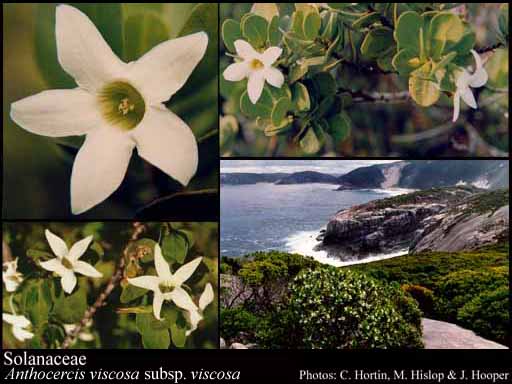- Reference
- Gen.Pl. [Jussieu] 124 (1789)
- Name Status
- Current

Scientific Description
Common name. Potato Family.
Habit and leaf form. Herbs, herbaceous climbers, shrubs, trees, and lianas (often prickly); resinous, or not resinous. Annual, or biennial, or perennial; plants with a basal concentration of leaves, or with neither basal nor terminal concentrations of leaves. Self supporting, or climbing; the climbers stem twiners, or scrambling. Helophytic to xerophytic. Leaves alternate, or alternate to opposite (usually alternate below, but often becoming opposite towards the inflorescence); usually spiral (at least below); ‘herbaceous’, or leathery; petiolate (usually), or subsessile, or sessile; non-sheathing; gland-dotted (rarely, e.g. Anthocercis), or not gland-dotted; aromatic, or foetid (depending on assignment of (e.g.) Anthocercis), or without marked odour (mostly); simple, or compound; epulvinate; when compound, ternate, or pinnate. Leaf blades dissected, or entire; when simple/dissected, pinnatifid; pinnately veined; cross-venulate. Leaves without stipules; without a persistent basal meristem. Domatia recorded (from 4 genera); represented by hair tufts. Stem anatomy. Nodes unilacunar (with 2 or 3 traces). Secondary thickening developing from a conventional cambial ring (usually), or anomalous; from a single cambial ring.
Reproductive type, pollination. Fertile flowers hermaphrodite. Unisexual flowers absent. Plants hermaphrodite (usually). Entomophilous.
Inflorescence and flower features. Flowers solitary, or aggregated in ‘inflorescences’. The terminal inflorescence unit apparently cymose. Inflorescences terminal, or axillary, or leaf-opposed (occasionally). Flowers small to medium-sized; fragrant (e.g. Nicotiana, Anthocercis), or malodorous (e.g. Anthocercis, according to interpretation), or odourless; regular (usually, more or less), or somewhat irregular to very irregular. The floral asymmetry when noticeable) involving the perianth, or involving the androecium, or involving the perianth and involving the androecium. Flowers commonly 5 merous; cyclic; tetracyclic. Free hypanthium absent. Hypogynous disk usually present; intrastaminal. Perianth with distinct calyx and corolla; (6–)10(–14); 2 -whorled; isomerous, or anisomerous. Calyx (4–)5(–7); 1 -whorled; gamosepalous; regular (usually); persistent; accrescent, or non-accrescent. Corolla (4–)5(–7); 1 -whorled; gamopetalous. Corolla lobes markedly shorter than the tube to markedly longer than the tube. Corolla contorted and plicate (usually), or imbricate, or valvate, or contorted; rotate, or campanulate, or funnel-shaped, or tubular; regular (usually, more or less), or regular to unequal but not bilabiate, or bilabiate (rarely). Androecium 5 (usually), or 3–4 (rarely), or 6–7 (rarely). Androecial members adnate (epipetalous, on the tube); all equal (often), or markedly unequal; free of one another; 1 -whorled. Androecium exclusively of fertile stamens (usually), or including staminodes (Salpiglossidae). Staminodes when present, 1, or 3 (Schizanthus). Stamens 5 (in all but Salpiglossideae), or 2, or 4. Staminal insertion near the base of the corolla tube, or midway down the corolla tube, or in the throat of the corolla tube. Stamens inserted at markedly different levels, or all inserted at the same level; didynamous (e.g. Anthocercis), or not didynamous, not tetradynamous (mostly); reduced in number relative to the adjacent perianth (rarely), or isomerous with the perianth; oppositisepalous; all alternating with the corolla members. Filaments appendiculate (e.g., inconsistently lobed in Anthocercis), or not appendiculate. Anthers connivent (often touching in a ring at their tops), or separate from one another; dorsifixed (e.g. Nicandra), or basifixed (e.g. Solanum, Physalis); dehiscing via pores to dehiscing via short slits (terminally), or dehiscing via longitudinal slits; extrorse (e.g. Anthocercis), or introrse (usually, if dehiscence not terminal); tetrasporangiate. Pollen shed in aggregates (rarely), or shed as single grains; in Salpiglossis, in tetrads. Gynoecium 2 carpelled. The pistil 2 celled (mostly), or 3–5 celled (Nicandreae and Datureae, by secondary divisions). Gynoecium syncarpous; synstylovarious to eu-syncarpous; superior. Ovary plurilocular; 2 locular. Locules secondarily divided by ‘false septa’ (Nicandreae and Datureae), or without ‘false septa’. Gynoecium oblique (the posterior carpel to the right, as expressed in conventional floral diagams); stylate. Styles 1; attenuate from the ovary; apical. Stigmas 1–2; if regarded as single, 2 - lobed; wet type, or dry type; papillate, or non-papillate; Group II type, or Group III type, or Group IV type. Placentation axile (the placentae usually more or less swollen). Ovules 1–50 per locule (i.e. to ‘many’); non-arillate; anatropous, or hemianatropous.
Fruit and seed features. Fruit fleshy, or non-fleshy; dehiscent, or indehiscent; a capsule, or a berry, or a drupe. Capsules septicidal (commonly), or loculicidal, or valvular, or circumscissile (Hyoscyamus). Seeds endospermic (usually). Endosperm oily (usually), or not oily (rarely starchy). Seeds with starch (rarely), or without starch. Cotyledons 2. Embryo achlorophyllous (13/21); straight, or straight to curved, or curved (or annular: curved through more than a semicircle in Nicandreae, Solaneae and Datureae, straight or only slightly curved in Cestreae and Salpiglossideae). Seedling. Germination phanerocotylar.
Physiology, biochemistry. Aluminium accumulation demonstrated (rarely). Photosynthetic pathway: C3.
Geography, cytology, number of species. World distribution: absent only from cold regions, but with greatest diversity in Central and South America. X = 7–12(+). 2000 species (or more).
Economic uses, etc. Products include potato and eggplant (Solanum spp.), and tomato (Lycopersicon). Other edible fruits from Physalis (cape gooseberry, strawberry tomato, jamberberry, sugar cherry, chinese lantern etc., according to the species and variety), Cymphomandra (tamarillo), Capsicum (sweet and chilli peppers), etc. Most produce poisonous alkaloids, and some are commercially important in this connection (Nicotiana, Hyoscyamus, Datura). Many cultivated ornamentals, e.g. Petunia, Lycium, Solanum, Cestrum, Solandra.